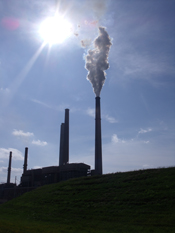19 April 2012
WASHINGTON—Researchers have developed a new monitoring technique to distinguish emissions from man-made fossil fuels in the atmosphere from other gases, a technique that likely could be used to monitor the effectiveness of measures regulating greenhouse gases.

A new study uses measurements of a specific type of carbon dioxide to detect emissions from fossil fuels. Pictured, Conesville Power Plant in Ohio. (Credit: Wikimedia user Ibagli)
The team examined six years-worth of atmospheric gas measurements of carbon dioxide (CO) and other gases, taken by aircraft every two weeks. Their method allowed them to separate CO2 derived from fossil fuels from CO2 being emitted by biological sources, such as plant respiration, said Scott Lehman, a senior research associate at the University of Colorado, Boulder, who led the study with John Miller, a research associate at the university.
The separation was made possible by the fact that CO2 released from burning of fossil fuels like coal, oil, and gas has no carbon-14, a radioactive form of carbon that is constantly forming in Earth’s atmosphere. Because carbon-14 is radioactive, it decays, or transforms, into another, nonradioactive element over time. Half of a given amount of the substance decays every 5,700 years so fossil fuels, which are derived from remains of plants and other organic matter that accumulated millions of years ago, no longer contain the radioactive carbon. In contrast, CO2 emitted from current biological sources is relatively rich in carbon-14. It’s a significant enough difference for atmospheric scientists to detect, Lehman said.
In the long run, measuring carbon-14 in the atmosphere offers the possibility to directly track country and state emissions of fossil-fuel CO2, said Miller. The technique would be an improvement over traditional, “accounting-based” methods of estimating emission rates of CO2 and other gases, which generally rely on reports from particular countries or regions regarding the use of coal, oil, and natural gas, he said.
“While the accounting-based approach is probably accurate at global scales, the uncertainties rise for smaller-scale regions,” said Miller, also with the National Oceanic and Atmospheric Administration’s (NOAA) Earth System Research Laboratory in Boulder. “And as CO2 emissions targets become more widespread, there may be a greater temptation to under-report. But we’ll be able to see through that.”
A paper on the subject was published April 19 in the Journal of Geophysical Research-Atmospheres, a publication of the American Geophysical Union.
The researchers also measured concentrations of 22 other atmospheric gases tied to human activities. One surprise in the study was that the researchers detected continued emissions from methyl chloroform and several other gases banned from production in the United States. Such observations emphasize the importance of independent monitoring, since the detection of such emissions could be overlooked by the widely used accounting-based estimation techniques, said Stephen Montzka, with NOAA’s Earth System Research Laboratory, who worked on the study.
Fossil fuel emissions have driven Earth’s atmospheric CO2 from concentrations of about 280 parts per million in the early 1800s to about 390 parts per million today, Miller said. The vast majority of climate scientists believe higher concentrations of the greenhouse gas CO2 in Earth’s atmosphere are directly leading to rising temperatures on the planet.
“We think the approach offered by this study can increase the accuracy of emissions detection and verification for fossil fuel combustion and a host of other man-made gases,” Lehman said. He added that using such a method involving carbon-14 has been supported by the National Academy of Sciences and could be an invaluable tool for monitoring greenhouse gases by federal agencies like NOAA.
Joint Press Release
AGU Contact:
Kate Ramsayer, +1 (202) 777-7524, [email protected]
University of Colorado Contact :
Jim Scott, +1 (303) 492-3114[email protected]
Journalists and public information officers (PIOs) of educational and scientific institutions who have registered with AGU can download a PDF copy of this paper in press by clicking on this link
Or, you may order a copy of the final paper by emailing your request to Kate Ramsayer at
[email protected]. Please provide your name, the name of your publication, and your phone number.
Neither the paper nor this press release are under embargo.
“Linking emissions of fossil fuel CO2 and other anthropogenic trace gases using atmospheric 14CO2”
John B. Miller: NOAA Earth System Research Laboratory, Boulder, Colorado, USA and Cooperative Institute for Research in Environmental Science, University of Colorado Boulder, Boulder, Colorado, USA;
Scott J. Lehman: Institute for Arctic and Alpine Research, University of Colorado Boulder, Boulder, Colorado, USA;
Stephen A. Montzka: NOAA Earth System Research Laboratory, Boulder, Colorado, USA;
Colm Sweeney, Benjamin R. Miller and Anna Karion: NOAA Earth System Research Laboratory, Boulder, Colorado, USA, and Cooperative Institute for Research in Environmental Science, University of Colorado Boulder, Boulder, Colorado, USA;
Chad Wolak: Institute for Arctic and Alpine Research, University of Colorado Boulder, Boulder, Colorado, USA;
Ed J. Dlugokencky: NOAA Earth System Research Laboratory, Boulder, Colorado, USA;
John Southon: Department of Earth System Science, University of California, Irvine, California, USA;
Jocelyn C. Turnbull: NOAA Earth System Research Laboratory, Boulder, Colorado, USA, Cooperative Institute for Research in Environmental Science, University of Colorado Boulder, Boulder, Colorado, USA;
Pieter P. Tans: NOAA Earth System Research Laboratory, Boulder, Colorado, USA.
Scott Lehman, Phone: +1 (303) 492-8980, Email: [email protected]
John Miller, Phone: +1 (303) 497-7739, Email: [email protected]